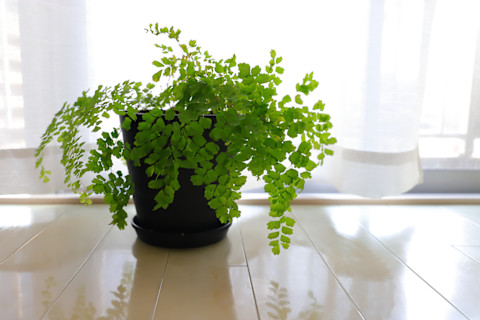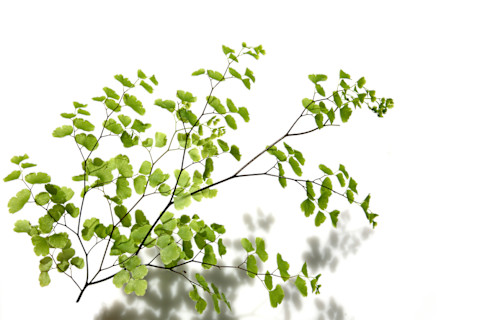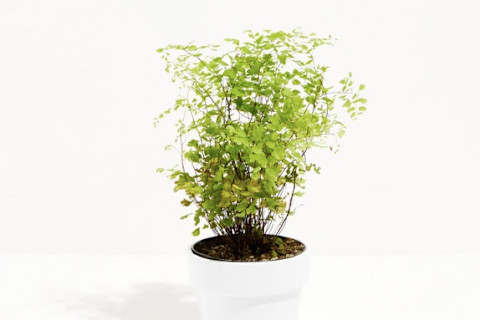There are over 200 species of Maidenhair Ferns, or Adiantum, growing in lush areas around the world. You can spot these plants by their gentle leaves and layered shape. More delicate than many popular houseplants, they can add a nice softness to any indoor jungle, too. But be warned: They are finicky!
Here's what plant experts say you need to know to keep these choosy beauties alive and well.
Quick overview.
Maidenhair Ferns naturally grow in many climates, from forests of the Northeast U.S. to highlands of the Andes mountains. They're commonly found in wet, high-humidity spots, like wedged between rocks next to a waterfall.
The genus name Adiantum is actually derived from the Greek word adiantos, or "unwetted," because these ferns' leaves repel water, explains Maria Failla, the host of the Bloom & Grow Radio podcast, and therefore need to frequently replenish water supplies to stay healthy.
Fast facts on the Maidenhair Fern
Sunlight needs:
Bright, indirect light
When to water:
Whenever the soil feels dry, usually 1-2 times a week
Pros:
Pretty, delicate-looking leaves
Cons:
Finicky about water and soil
Where to put them:
Near eastern or northern-facing windowsills
Pet friendly?
Yes! Maidenhair Ferns won't harm your pets
Size:
1-2 feet tall
Care tips.
It's difficult to recreate the misty environment of a waterfall indoors, which is why Maidenhair Ferns can make for such high-maintenance houseplants. Follow these tips to keep yours happy.
Sunlight:
When considering where to place yours at home, look for a spot that gets ample light but doesn't sit in direct sun all day. Near eastern or northern-facing windowsills, but not directly on them, is a good bet.
Humidity:
Then, consider humidity: Ferns hate dry air and should be placed as far from air conditioning units as possible. Terra cotta pots can also dry out these ferns' soil, according to Failla, so consider keeping your plant in the plastic pot it came in and then placing that in the decorative planter of your choice.
"Drainage holes are also important with ferns because they like moist soil but not soggy soil," she adds, "so it's important for the water to be able to drain out the bottom of the pot during the frequent waterings." If your pot doesn't come with a drainage hole, here's how to create one.
To further boost humidity, you can place your fern next to other greenery (plants naturally emit humidity when next to other plants!), next to a humidifier, inside an enclosed glass cloche or terrarium, or even in your bathroom. "If you have natural light, it will love the moisture given off by your showers and baths every day," says Failla.

Water:
While Maidenhair Ferns need a lot of water to survive, it is possible to overwater them, according to Puneet Sabharwal of plant subscription service horti. He recommends starting with a base of well-draining soil mixed with peat moss and checking its moisture level every few days. Whenever the top of the soil feels even slightly dry, it's time to water. Here are some more cues your plant needs a drink.
This need for constant monitoring makes the Maidenhair a prime candidate for a self-watering pot. You can buy one online or from a local plant shop, or make your own using a cup of water and a piece of string. "Place the cup of water near the fern, run the string from the cup of water and tuck it into the soil of the plant," says Failla. "The moisture from the string will help keep your soil moist. This is also a great hack for when you need to travel and leave your plants alone!"
Fertilizer:
Fertilize your Maidenhair Fern about once a month during the spring and summer months (unless it's brand-new, in which case it probably won't need the added nutrients). You can stop fertilizing come the first fall chill since that's when the plant will head into its dormancy phase.
Be sure to dilute your fertilizer in enough water since too many nutrients at once can cause the Maidenhair's leaves to brown.

How to repot.
Maidenhair Ferns have delicate leaves and roots. You'll want to be careful when repotting yours, which you should do any time that you notice its roots poking through the top or bottom of its planter. You can also divide a healthy, mature Maidenhair Fern into multiple plants and give each one its own pot.
Check out our full guide to repotting here, or follow along with the quick process below:
- Gently squeeze your plant out of its existing pot.
- Shake off excess soil to expose your plant's roots. If you are dividing your plant, this is where you'll want to gently split it into sections. Lightly hold a few of its fronds in your hand and pull them away from the rest of the plant, dividing its roots.
- Place a thin layer of fresh soil in your new pot (remember, it needs to have a drainage hole) to prop up your Maidenhair Fern.
- Place your plant on top of this new soil and then fill soil around its perimeter, making sure to pack it in tightly.
- Water your plant immediately and let it get used to its new digs.
Signs of distress:
- Brown, wrinkled leaves: Your fern is probably too dry. "If your plant seems like it's drying out, fully soak the soil to give it a fighting chance," says Sabharwal. Even if sections of your plant have completely browned, he says you might be able to nurse them back to health: "Maidenhair ferns can often resurrect from the dead if you groom the plant by cutting the dried leaves and giving it plenty of indirect sunlight."
- Pale leaves that keep dropping: Your fern isn't getting enough light. Move it to a slightly sunnier spot and see if it helps.
- Yellow leaves: This can mean a lot of things, says Failla, including too little humidity, water, or light. "First and foremost," she reiterates, "make sure soil is continually evenly moist. Then address the light and humidity adjustments."
- Dots on the ends of the leaves: These are likely spores, and they may look funny but are actually a sign that your plant is growing and developing. Failla says that if you spot them, you should consider it a proud plant parent moment.
Final care tips.
Here are some more best practices for keeping these finicky ferns happy:
- Don't place your fern near or on top of a radiator or heater in the winter since that area will be too dry.
- Trim your fern regularly. "You will most likely have several fronds turn brown or die back," Failla explains. "Simply trim them back, continue caring for the plant, and new fronds will grow."
- Maidenhair Ferns grow from underground root systems called rhizomes. If your fern is healthy and you want to use it to propagate it into a new plant pal, carefully divide the root into three or four chunks during the springtime and then place each one in its own pot. (Check out this guide to plant propagation for more on this technique.)
Shop this plant.
Buy Maidenhair Ferns at your local plant shop, garden center, or using the links below:
The takeaway.
Maidenhair Ferns are super delicate, but if you can get the hang of maintaining a wet, well-drained environment for them, they can live a long and lush life. This fragile beauty would look great next to a more striking, hardy variety like a snake plant or Ficus Audrey.



